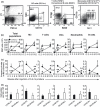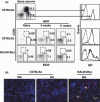Distinct granuloma responses in C57BL/6J and BALB/cByJ mice in response to pristane
- PMID: 20681981
- PMCID: PMC2974958
- DOI: 10.1111/j.1365-2613.2010.00725.x
Distinct granuloma responses in C57BL/6J and BALB/cByJ mice in response to pristane
Abstract
Granuloma formation is an inflammatory response of the host against invading pathogens or indigestible substances. We generated mesenteric oil granulomas by injecting pristane into the peritoneal cavity (PC) of mice, and compared oil granuloma formation in the C57BL/6J and BALB/cByJ strains of mice. The formation and kinetics of oil granulomas were distinct between the two strains. In C57BL/6J mice, injected pristane induced oil granuloma formation at both the mesenteric centers (MG) and margins (SG). MG was resolving by 11 weeks, and SG persisted. In BALB/cByJ mice, MG developed slower but persisted longer than in C57BL/6J mice, and SG resolved sooner than in C57BL/6J mice. Injection of India ink revealed that phagocytes were localised mainly to the SG in C57BL/6J mice, but were located diffusely in both MG and SG of BALB/cByJ mice. SG cells expressed more monocyte chemotactic protein-1 (MCP-1) mRNA than MG cells in C57BL/6J mice, but there was no difference in MCP-1 expression between the MG and SG in BALB/cByJ mice. These observations suggest that the recruitment of inflammatory leucocytes under the direction of chemokines differentiates the patterns of granuloma responses to pristane in C57BL/6J and BALB/cByJ mice.
© 2010 The Authors. Journal compilation © 2010 Blackwell Publishing Ltd.
Figures





Similar articles
-
Genetic regulation of pristane-induced oil granuloma responses.Int J Exp Pathol. 2010 Oct;91(5):472-83. doi: 10.1111/j.1365-2613.2010.00732.x. Epub 2010 Aug 27. Int J Exp Pathol. 2010. PMID: 20804539 Free PMC article.
-
Differential immune reactivity to stress in BALB/cByJ and C57BL/6J mice: in vivo dependence on macrophages.Physiol Behav. 1998 Aug;65(1):95-103. doi: 10.1016/s0031-9384(98)00149-8. Physiol Behav. 1998. PMID: 9811371
-
mRNA expression in mouse hypothalamus and basal forebrain during influenza infection: a novel model for sleep regulation.Physiol Genomics. 2006 Feb 14;24(3):225-34. doi: 10.1152/physiolgenomics.00005.2005. Epub 2006 Jan 10. Physiol Genomics. 2006. PMID: 16403846
-
Kinetics of ectromelia virus (mousepox) transmission and clinical response in C57BL/6j, BALB/cByj and AKR/J inbred mice.Lab Anim Sci. 1985 Feb;35(1):41-6. Lab Anim Sci. 1985. PMID: 2984458
-
Francisella tularensis Vaccines Elicit Concurrent Protective T- and B-Cell Immune Responses in BALB/cByJ Mice.PLoS One. 2015 May 14;10(5):e0126570. doi: 10.1371/journal.pone.0126570. eCollection 2015. PLoS One. 2015. PMID: 25973794 Free PMC article.
Cited by
-
Regulation of Leukocyte Recruitment to the Spleen and Peritoneal Cavity during Pristane-Induced Inflammation.J Immunol Res. 2017;2017:9891348. doi: 10.1155/2017/9891348. Epub 2017 Oct 19. J Immunol Res. 2017. PMID: 29201923 Free PMC article.
-
RORγt modulates macrophage recruitment during a hydrocarbon oil-induced inflammation.PLoS One. 2013 Nov 15;8(11):e79497. doi: 10.1371/journal.pone.0079497. eCollection 2013. PLoS One. 2013. PMID: 24260235 Free PMC article.
-
Microvascular lung injury and endoplasmic reticulum stress in systemic lupus erythematosus-associated alveolar hemorrhage and pulmonary vasculitis.Am J Physiol Lung Cell Mol Physiol. 2022 Dec 1;323(6):L715-L729. doi: 10.1152/ajplung.00051.2022. Epub 2022 Oct 18. Am J Physiol Lung Cell Mol Physiol. 2022. PMID: 36255715 Free PMC article.
-
Galectin-3 orchestrates the histology of mesentery and protects liver during lupus-like syndrome induced by pristane.Sci Rep. 2019 Oct 10;9(1):14620. doi: 10.1038/s41598-019-50564-8. Sci Rep. 2019. PMID: 31601823 Free PMC article.
-
Efficient role of IgH 3' regulatory region deficient B-cells in the development of oil granulomas.Oncotarget. 2016 Jun 21;7(25):38741-38749. doi: 10.18632/oncotarget.9588. Oncotarget. 2016. PMID: 27231852 Free PMC article.
References
-
- Bean AG, Roach DR, Briscoe H, et al. Structural deficiencies in granuloma formation in TNF gene-targeted mice underlie the heightened susceptibility to aerosol Mycobacterium tuberculosis infection, which is not compensated for by lymphotoxin. J. Immunol. 1999;162:3504–3511. - PubMed
-
- Birkness KA, Guarner J, Sable SB, et al. An in vitro model of the leukocyte interactions associated with granuloma formation in Mycobacterium tuberculosis infection. Immunol. Cell Biol. 2007;85:160–168. - PubMed
-
- Bowers RR, Houston F, Clinton R, Lewis M, Ballard R. A histological study of the carrageenan-induced granuloma in the rat lung. J. Pathol. 1980;132:243–253. - PubMed
-
- Chiu BC, Chensue SW. Chemokine responses in schistosomal antigen-elicited granuloma formation. Parasite Immunol. 2002;24:285–294. - PubMed
-
- Co DO, Hogan LH, Il-Kim S, Sandor M. T cell contributions to the different phases of granuloma formation. Immunol. Lett. 2004;92:135–142. - PubMed
Publication types
MeSH terms
Substances
Grants and funding
LinkOut - more resources
Full Text Sources
Research Materials
Miscellaneous

